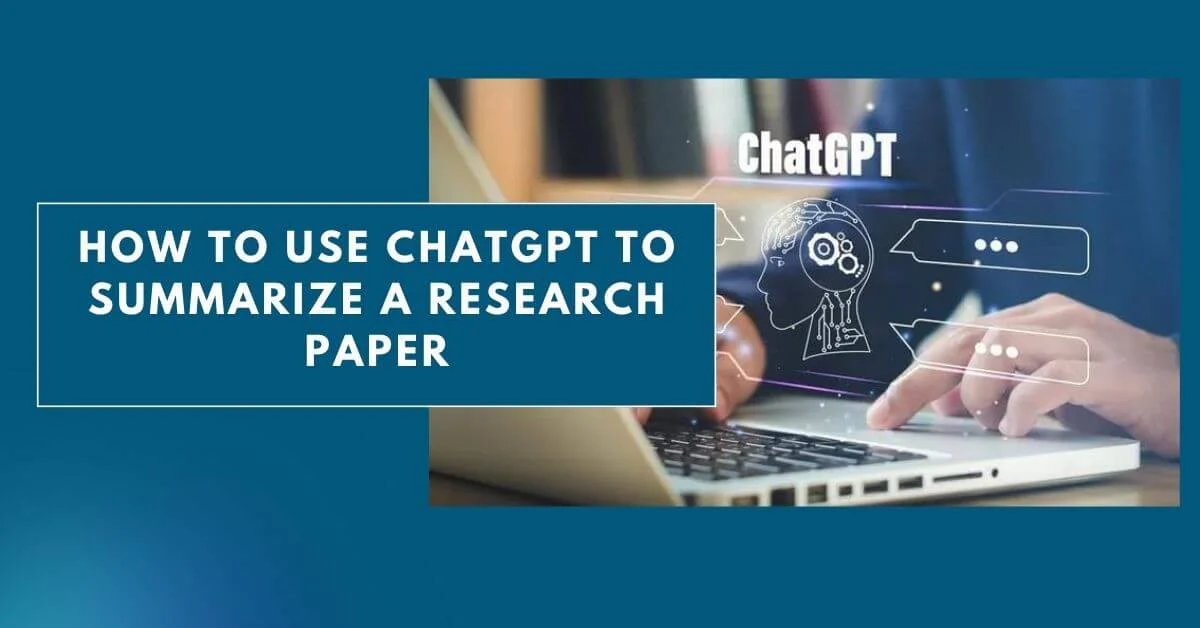How to Use ChatGPT to Summarize a Research Paper – A Guide

Have you ever encountered difficulty producing a straightforward and concise summary of a research paper? Do you desire an instrument that could facilitate the rapid extraction of the principal arguments and significant discoveries from an intricate scholarly article? If so, ChatGPT, a conversational AI model that can respond to your queries and engage in dialogue with you, maybe something to consider.
OpenAI’s ChatGPT is a language model capable of producing coherent and natural texts in response to user input. In addition to these capabilities, it is also capable of revising, summarizing, and generating content. This blog post will demonstrate in a few straightforward stages how to summarize a research paper using ChatGPT.
Step-by-Step Guide How to Use ChatGPT to Summarize a Research Paper
Step 1:
Choose a research paper that you want to summarize and copy its abstract or introduction.
Identifying a research paper that piques your interest and that you intend to summarize is the initial phase. You may utilize any search engine or online database to locate papers on the subject or field of your choosing.
After selecting a paper, duplicate its introduction or abstract. This will provide a synopsis of the objectives, methodologies, findings, and conclusions of the document.
Step 2:
Go to chat.openai.com and start a conversation with ChatGPT. Paste the abstract or introduction as your first message and ask ChatGPT to summarize it in one sentence.
Register for a free account at chat.openai.com as per the following procedure. This will enable you to launch ChatGPT and initiate a conversation with it.
Paste the abstract or introduction that you copied in the previous step as your initial message to ChatGPT once you have successfully logged in. Request that ChatGPT condense the information into a single sentence.
For instance, you might state the following:
“Could you kindly condense this abstract into a single sentence?” or “What does this introduction’s main idea convey?”
After receiving your input, ChatGPT will generate a reply. One sentence that encapsulates the key arguments of the abstract or introduction and attempts to convey the essence of the paper will be utilized. Here is an illustration of a possible response from ChatGPT:
- Utilizing graph theory and deep learning, this article presents an innovative approach to image segmentation that exhibits exceptional performance across a variety of datasets.
Step 3:
Review the summary of the research paper that ChatGPT generates and edit it if needed. You can also ask ChatGPT follow-up questions or request clarifications if something is unclear.
Reviewing and revising the ChatGPT-generated summary is the third stage. One may verify whether the summary is precise, succinct, and unambiguous.
Additionally, one may assess whether the revised abstract or introduction adequately addresses every significant element of the manuscript. You may either modify the summary manually or request ChatGPT to do so if you discover any errors or omissions.
For instance, you might state the following:
“Could you please provide a more precise summary?” or “Could you provide additional information regarding the outcomes?”
You may also seek clarifications or ask follow-up questions of ChatGPT regarding any ambiguous information.
For instance, you might state the following:
“Explain what deep learning entails.” alternatively stated: “In what ways does graph theory contribute to the process of image segmentation?”
ChatGPT will subsequently attempt to provide clarifications on unfamiliar terms or address inquiries.
Step 4:
Repeat steps 1-3 for other sections of the paper, such as methods, results, discussion, and conclusion.
Repetition of steps 1-3 for the remaining sections of the paper, including the methods, results, discussion, and conclusion, constitutes the final stage.
One can employ an identical procedure encompassing copying, pasting, inquiring, evaluating, and editing to produce summaries for every segment of the manuscript. This will facilitate the development of a thorough comprehension of the paper’s substance and organization.
You will be able to quickly and easily summarize a research paper using ChatGPT by adhering to these steps.
You will also have the opportunity to learn more about the paper’s subject and methodology through interactions with ChatGPT.
Check Also: How to Use ChatGPT to Prepare for Job Interview 2023
Benefits of ChatGPT to Summary of Research Paper:
- Efficient operation: ChatGPT is capable of rapidly analyzing and comprehending the substance of a research paper, generating a succinct synopsis within a comparatively meager timeframe. Readers and researchers can save considerable time and effort as a result.
- About Precision: ChatGPT is capable of producing summaries that exhibit a notable level of precision, centered on the most critical and pertinent details presented in the document. This can aid readers in comprehending the paper’s primary contributions and findings more rapidly.
- The Objectivity: ChatGPT produces summaries by the substance of the paper, devoid of subjective interpretation or personal bias. This guarantees the impartiality and objectivity of the summary.
- Holding steady: ChatGPT can consistently create summaries. This lowers the chance of differences in quality or style that could happen when different people try to summarize the same paper.
- Ensuring Accessibility: By using summaries made by ChatGPT, complicated research can be made easier to understand for a wider audience, even those who don’t have the technical knowledge to fully understand the original paper.
- Reducing time: ChatGPT enables professionals and researchers to promptly determine the applicability of a research paper to their interests or work before devoting the necessary time to thoroughly reading the entire paper. This may contribute to the process of reaching a decision.
- Multilingual assistance: ChatGPT possesses the capability to produce summaries in an extensive array of languages, rendering it an invaluable instrument for scholars who must comprehend articles written in tongues beyond their own.
- The ability to scale: ChatGPT is highly efficient for large-scale data analysis projects, meta-analyses, and systematic literature reviews due to its capacity to process a substantial volume of research papers in a brief period.
- A personalized touch: When ChatGPT users are making summaries, they can give clear instructions or criteria, which means that the summary can be made to fit each person’s needs or preferences.
- Lifelong learning: By being trained on current data, ChatGPT can become cognizant of the most recent developments and trends in research. This feature renders it an invaluable instrument for remaining informed in a domain that is undergoing rapid change.
Conclusion:
We demonstrated in this blog post how to summarize a research paper with ChatGPT in a few straightforward steps. We sincerely hope that this guide will assist you in writing summaries for academic papers, saving you time and effort in the process. In addition to summarization, ChatGPT can be employed for various purposes, including content generation, text revision, and inspiration discovery, among others.
ChatGPT is an extraordinary instrument that can assist you with a wide range of writing opportunities and challenges. Nevertheless, it is not flawless and may occasionally generate nonsensical or erroneous texts. Therefore, before employing its outputs for any purpose, you should consistently evaluate them thoroughly and exercise your discretion.
People Also Ask:
-
Can ChatGPT summarize research articles?
AI chatbots like ChatGPT can be used to make summarizing long articles, research papers, and books an easier job.
-
How do you use ChatGPT in a research paper?
Brainstorm research questions.
Develop a methodology.
Create an outline.
Find sources.
Summarize and paraphrase the text.
Provide feedback. -
Can ChatGPT read PDFs and summarize them?
Once your PDF is uploaded, you can instruct ChatGPT to summarize the document. Simply ask a question or provide a command like, “Please summarize the PDF,” or you can be more specific with your request, such as “Summarize the key findings in the PDF.” You can also ask any question related to the content of the PDF.



